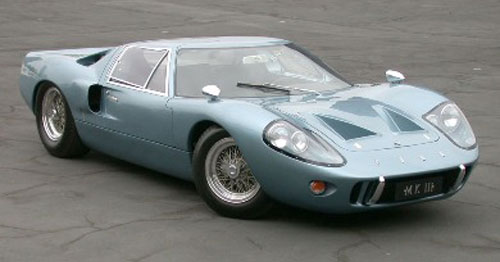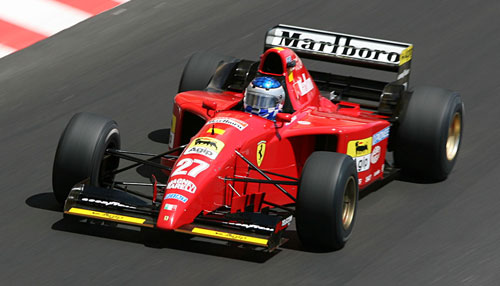The Aesthetics of Racing: Ford GT40

Pure function can be brutally attractive.
Even though its profile changed in detail between its four incarnations, whatever specific shape it took, the legendary Ford GT40 epitomizes the function-as-form racer aesthetic.
The Mark I and II shape, shown above, remains the most well-known GT40 variation. The car’s genesis is familiar to most car buffs: After an aborted attempt to buy Ferrari outright, a racing-victory-hungry Henry Ford II decided to build his own Ferrari beater, and after a few years of working out the kinks, scored 4 straight 24 Hours of Le Mans victories from 1966 through 1969. The body of the 427-powered Mark II, which delivered the first Le Mans victory in 1966, was a British-based Lola creation, so it was technically an Anglo-American car. Still, whoever made it, the GT40’s design is absolutely arresting (especially for the mid-’60s), devoid of anything that would compromise its singular mission. There were no wings, no frills, no fancy multi-cam V12s—just brute American pushrod force to complement the stubby, blue-collar shape.

With the Mark III, shown above, Ford civilized the GT40 just a bit for road use. It’s a tribute to the basic appeal of the car’s proportions that the only major external changes came in the form of different headlight clusters and a slightly lengthened tail for additional storage. A contemporary of the groundbreaking Lamborghini Miura (the first mid-engined supercar), the GT40’s dynamics and racing pedigree easily trumped the Italian exotic’s. Sadly, only 7 were made.

The wholly made-in-America Mark IV was a substantially different beast. Even though it retained the same overall look and feel as its predecessors, much of its aesthetic appeal was sacrificed in the name of additional aerodynamic refinement. Dispensing with the Lola-designed bodywork, Ford brought the design in-house, tweaking and refining the basic theme. The Mark IV kept the GT40’s signature stubby shape, and delivered the only true all-American Le Mans victory, driven by the all-star pairing of Dan Gurney and A. J. Foyt in 1967.
I don’t know that there’s even been a car quite as effective looking as the GT40. Delicate F1 racers and more modern endurance machines are typically festooned and underpinned with far more sophistication, but the results seem to be cars that politely ask the elements (air, road surface, etc) to cooperate. The GT40, on the other hand, commands respect; its shape demands compliance from its partners in victory. It gets the job done, not glamorously, but effectively, and there’s an undeniable beauty in that.
Editor’s note: This post is part of a series examining the aesthetic merits of cars designed almost wholly with function in mind. Read the other installments here:




